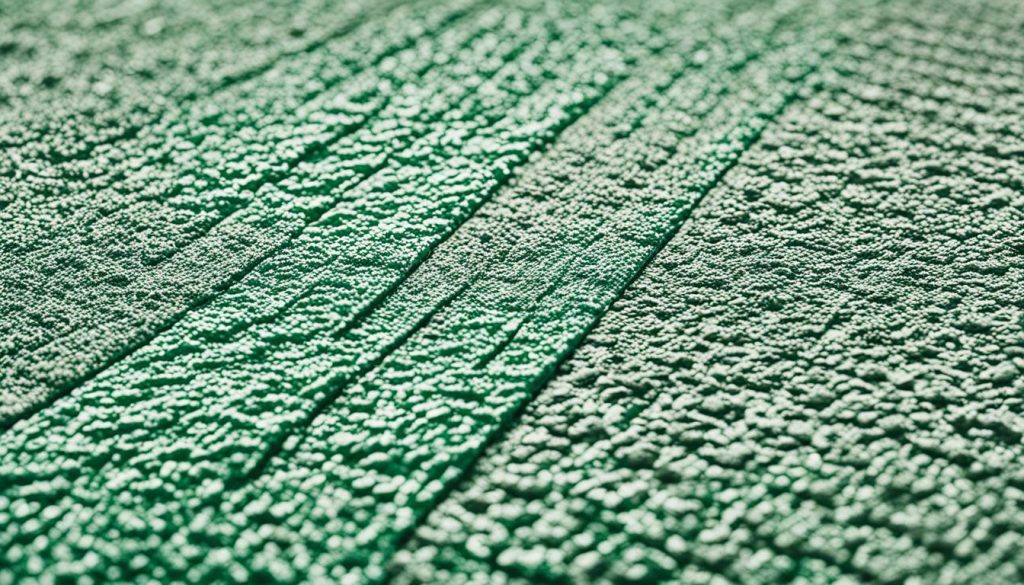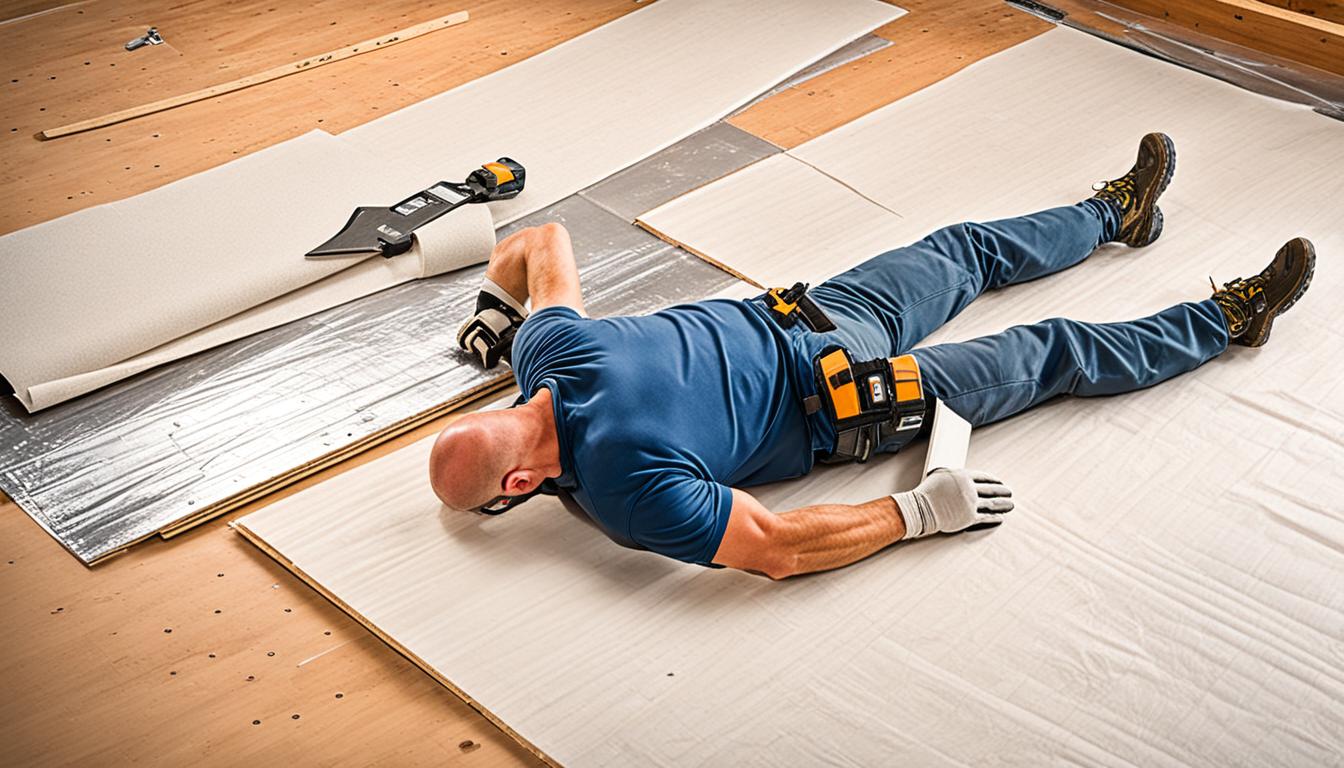Did you know that installing underlayment is a crucial step in flooring installation? It not only enhances the performance and durability of your flooring but also provides essential benefits such as sound insulation, moisture protection, and subfloor leveling. Whether you’re planning to install hardwood, laminate, or tile flooring, understanding the importance of underlayment and how to install it correctly is essential for a successful flooring project.
Key Takeaways:
- Underlayment is a thin layer of material that offers sound insulation, moisture protection, and subfloor leveling.
- Choosing the right underlayment is essential based on the type of flooring, soundproofing needs, moisture protection, and subfloor conditions.
- Top underlayment options like Noise Guard, QuietWalk, Silent Step, and Floor Acoustic provide unique benefits to enhance the comfort and performance of your flooring.
- Proper installation of underlayment is crucial for a successful flooring installation.
- Ensure to follow the manufacturer’s recommendations and guidelines for the specific underlayment materials.
Why is Underlayment Important?
Underlayment plays a crucial role in ensuring a successful and long-lasting flooring installation. It offers a range of important benefits that contribute to the overall performance and comfort of your floors.
Sound Insulation
One of the key advantages of underlayment is its ability to provide sound insulation. By reducing noise transmission, underlayment creates a quieter living space, making it ideal for homes, apartments, and commercial spaces. Whether you’re walking on your floors or there’s movement in the room above, underlayment helps minimize sound transfer, allowing you to enjoy a calm and peaceful environment.
Moisture Protection
Another significant benefit of underlayment is its role as a moisture barrier. It shields the flooring material from water damage, preventing issues such as warping, mold, and mildew. This is particularly important in areas prone to moisture, such as bathrooms, kitchens, and basements. With the right underlayment, you can ensure the longevity of your floors and protect your investment.
Subfloor Imperfections
Underlayment also helps to smooth out minor subfloor imperfections. It acts as a buffer between the subfloor and the flooring material, creating a level surface for installation. This is especially beneficial when installing laminate or engineered wood flooring, as any unevenness in the subfloor can affect the overall appearance and integrity of the floor. With underlayment, you can achieve a seamless and professional-looking installation.
The importance of choosing the right underlayment cannot be overstated. By selecting underlayment that addresses your specific needs, you can enhance the performance and lifespan of your floors. So, whether you want to enjoy a quieter living space, protect against moisture, or create a level surface, underlayment is an essential element in achieving your flooring goals.
| Benefits of Underlayment | Key Features |
|---|---|
| Sound Insulation | Reduces noise transmission |
| Moisture Protection | Acts as a barrier against water damage |
| Subfloor Imperfections | Smooths out minor unevenness |
Types of Underlayment
When it comes to choosing the right underlayment for your flooring, it’s important to consider various factors such as the type of flooring you have and your specific needs. Here are some of the different types of underlayment options available:
Foam underlayment: Made from materials like polyethylene or polypropylene, foam underlayment is lightweight and offers excellent sound insulation. It helps to reduce noise transmission, creating a quieter and more peaceful living space.
Cork underlayment: As a natural material, cork underlayment provides superior sound absorption and thermal insulation. It not only reduces noise but also helps to regulate temperature, making it an ideal choice for rooms that require both acoustic performance and comfort.
Rubber underlayment: If you’re looking for durability and exceptional sound insulation, rubber underlayment is a great option. It offers impact resistance and is often used for tile and stone flooring installations. Rubber underlayment provides added comfort and reduces noise effectively.
Each type of underlayment has its own unique properties and benefits. Consider your specific requirements and consult with a professional to select the best underlayment option for your flooring project.

How to Choose the Right Underlayment
Choosing the right underlayment is crucial for a successful installation. Consider the type of flooring you have and the manufacturer’s recommendations for underlayment materials. Assess your soundproofing needs and choose an underlayment with excellent sound insulation properties if noise reduction is important to you. Evaluate the level of moisture protection required, especially for areas prone to moisture. Take into account any subfloor conditions and choose an underlayment that can help level the surface and provide the necessary support. Finally, consider your budget and the longevity of your flooring. Some underlayment options may offer long-term benefits and durability, while others may be more cost-effective for shorter-term needs. By carefully considering these factors, you can select the right underlayment that will enhance the performance and longevity of your flooring.
Comparison of Underlayment Options
| Underlayment Option | Soundproofing | Moisture Protection | Subfloor Leveling | Longevity | Budget |
|---|---|---|---|---|---|
| Noise Guard underlayment | Excellent | Good | Some support | High | Higher cost |
| QuietWalk underlayment | Superior | Excellent | Minimal leveling | Medium | Moderate cost |
| Silent Step underlay | Good | Good | Significant leveling | High | Higher cost |
| Floor Acoustic underlayment | Excellent | Excellent | Minimal leveling | Medium | Moderate cost |

Top Underlayment Options
When it comes to selecting the right underlayment for your flooring, there are several top options available in the market. These underlayments offer unique benefits that can enhance the performance and comfort of your floors. Let’s take a closer look at some of the best choices:
Noise Guard underlayment
Noise Guard underlayment is specially designed to minimize sound transmission, making it an excellent choice for apartments or multi-story homes. With Noise Guard, you can enjoy a quieter living space, free from the noise associated with footsteps or other activities.
QuietWalk underlayment
If eliminating creaks and squeaks in your floor is a priority, QuietWalk underlayment is the ideal option. Its superior sound absorption properties ensure a peaceful environment by reducing noise from foot traffic and preventing the annoying sounds that can accompany walking on certain types of flooring.
Silent Step underlay
For those seeking exceptional cushioning and support, Silent Step underlay is the perfect choice. This underlayment provides a softer and more comfortable feel underfoot, making your floor a joy to walk on. The added cushioning also helps to reduce the impact on your joints, creating a more ergonomic and enjoyable flooring experience.
Floor Acoustic underlayment
If you’re looking to create a quiet environment in areas such as bedrooms or home offices, Floor Acoustic underlayment is the right option for you. Designed to reduce both airborne and impact noise, this underlayment ensures a peaceful and serene space where you can relax or concentrate without disturbances.
With these top underlayment options – Noise Guard, QuietWalk, Silent Step, and Floor Acoustic – you can find the perfect match for your flooring needs. Whether you’re prioritizing sound insulation, eliminating floor noises, enhancing comfort, or reducing noise pollution, these underlayments offer the right solution to elevate your flooring experience.
